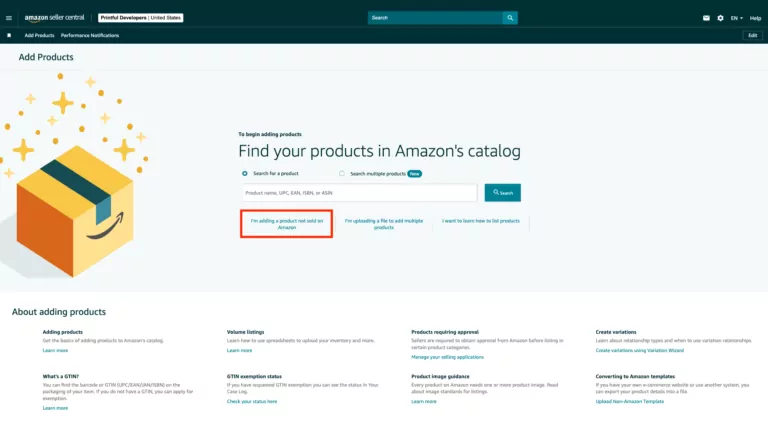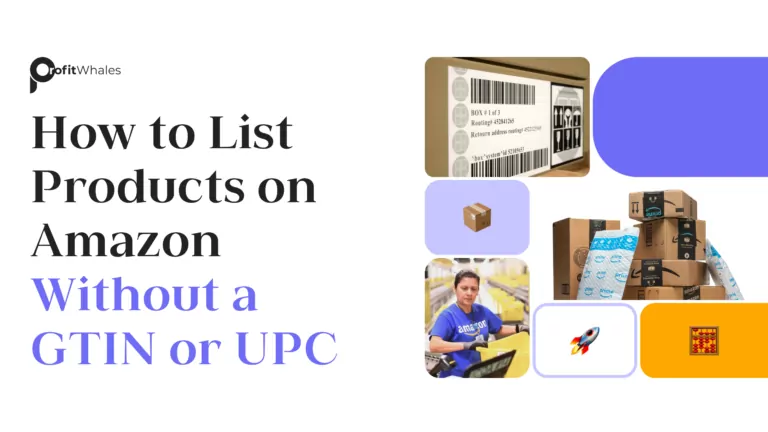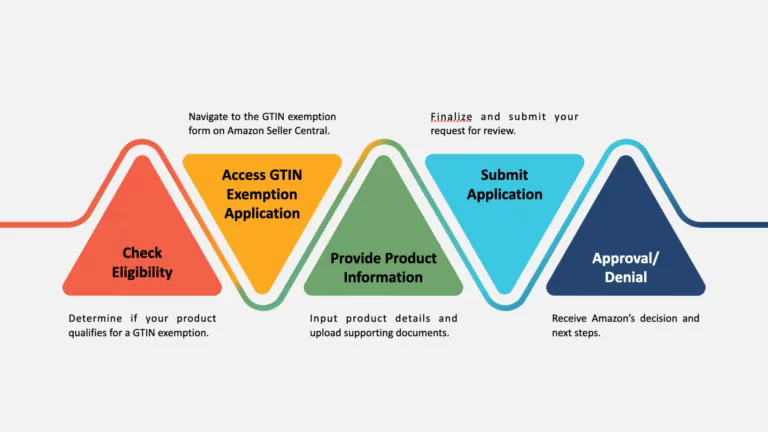Introduction to GTIN and UPC
Listing products on Amazon without a GTIN (Global Trade Item Number) or UPC (Universal Product Code) can be daunting for many sellers. These identifiers are typically required for most products to ensure uniqueness and traceability. They help maintain a structured catalog and facilitate seamless transactions for customers. However, there are situations where sellers can list products without these codes by applying for a GTIN exemption. This guide will provide a detailed overview of GTINs, UPCs, and the process of listing products on Amazon without them. Understanding these identifiers and how to navigate the exemption process can significantly impact your selling strategy and success on Amazon.
What is a GTIN?
A Global Trade Item Number (GTIN) is a unique global identifier to track and manage products. Developed by GS1, a non-profit organization that sets standards for business communication, GTINs include various identifiers such as UPCs, EANs (European Article Numbers), and ISBNs (International Standard Book Numbers). Each product variation, such as different sizes or colors, requires a unique GTIN to ensure accurate inventory management and product identification. GTINs play a crucial role in the supply chain, enabling retailers and manufacturers to track products from production to sale, ensuring efficiency and reducing errors.
Depending on the product type and region, GTINs can be 8, 12, 13, or 14 digits long. For example, a 12-digit GTIN is commonly called a UPC in North America, while a 13-digit GTIN is an EAN in Europe. Regardless of the length or format, the primary function of a GTIN is to provide a unique identifier that can be scanned and processed electronically, facilitating automation and data accuracy.
What is a UPC?
The Universal Product Code (UPC) is a specific type of GTIN commonly used in North America. It consists of a 12-digit number that uniquely identifies a product and is widely recognized by retailers and consumers. UPCs are essential for streamlining checkout, managing inventory, and facilitating product tracking in retail environments. They are typically represented by a barcode that can be scanned at the point of sale, enabling quick and accurate data capture.
UPCs help maintain accurate product listings on Amazon and prevent duplicate or counterfeit entries. Each UPC is linked to detailed product information, including the manufacturer, product description, and specifications. This ensures that customers receive accurate information about the products they purchase, enhancing trust and satisfaction. Moreover, UPCs aid in inventory management by allowing sellers and Amazon to track stock levels, manage reorders, and analyze sales trends.
UPCs are particularly important for products sold in multiple locations or through various channels. By providing a consistent identifier, UPCs enable seamless integration between different systems and platforms, reducing the risk of errors and discrepancies.
Why are GTIN and UPC Important for Amazon Listings?
GTINs and UPCs are crucial in maintaining the integrity of Amazon’s vast product catalog. They ensure that each product is uniquely identified, preventing duplication and counterfeit issues. These identifiers also enhance searchability, making it easier for customers to find the products they seek. When a customer searches for a product on Amazon, the GTIN or UPC helps match their query with the correct item, ensuring accurate search results and a better shopping experience.
Moreover, GTINs and UPCs help Amazon manage inventory more efficiently and ensure that product details are accurately displayed. This is particularly important for the fulfillment process, as accurate product information helps prevent shipping errors and ensures that customers receive the correct items. By using GTINs and UPCs, Amazon can automate many aspects of inventory management, such as stock updates and order processing, which improves operational efficiency and reduces costs.
Understanding Amazon’s Product Identifier Requirements
Amazon requires sellers to use specific product identifiers to maintain a well-organized and searchable product catalog. These identifiers help ensure the accuracy and uniqueness of each product listing, prevent duplicates and counterfeit issues, and improve the overall shopping experience for customers. Understanding these requirements is essential for successfully listing products on the platform and navigating the process of obtaining exemptions if needed.
Different Types of Product Identifiers
Amazon uses several types of product identifiers to manage its catalog effectively. Each identifier serves a specific purpose and is used in different regions or for specific types of products. Here are the most common types:
- GTIN (Global Trade Item Number): This is an umbrella term for various unique product identifiers, including UPC, EAN, and ISBN. GTINs ensure global uniqueness and are used to track and manage products internationally.
- UPC (Universal Product Code): Commonly used in North America, UPCs consist of a 12-digit number and are widely recognized by retailers and consumers. They are essential for streamlining checkout processes, managing inventory, and preventing duplicate listings.
- EAN (European Article Number): Used primarily in Europe, EANs are 13-digit identifiers that serve a similar purpose to UPCs. They are essential for product identification and inventory management in European markets.
- ISBN (International Standard Book Number): This 13-digit identifier is explicitly used for books. ISBNs are crucial for cataloging books in libraries and bookstores and for online listings on platforms like Amazon.
- JAN (Japanese Article Number): Similar to EANs, JANs are used in Japan and consist of 13 digits. They ensure the unique identification of products in the Japanese market.
These identifiers play a critical role in the global supply chain, ensuring that products are accurately tracked, managed, and listed across various platforms and regions.
When is a GTIN or UPC Required?
A GTIN or UPC is required for most products listed on Amazon. These identifiers are necessary to ensure product uniqueness, improve searchability, and prevent counterfeiting. Here’s a more detailed look at when these identifiers are required and when a GTIN exemption might be applicable:
- General Requirements: Amazon mandates the use of a GTIN or UPC for the majority of products. This requirement applies to new and used items, ensuring each product is uniquely identified and easily searchable. Having a GTIN or UPC also helps Amazon maintain a high level of data accuracy and integrity within its product catalog.
- Categories with Mandatory GTINs/UPCs: Certain product categories strictly require a GTIN or UPC. These include electronics, toys, beauty products, and health and personal care items. For these categories, the presence of a GTIN or UPC helps maintain standardized product listings and simplifies inventory management.
- Brand-Specific Requirements: Brands that are part of the Amazon Brand Registry program are also required to use GTINs or UPCs. This helps protect brand integrity and ensures that customers receive authentic products. Registered brands benefit from enhanced protection against counterfeit listings and unauthorized sellers.
- Exemptions and Special Cases: In some instances, a GTIN exemption may be granted. Sellers can apply for an exemption if their products fall into specific categories, such as handmade or custom-made items, private label products, or products without a manufacturer-assigned GTIN. Additionally, certain books and media items may qualify for exemptions. The exemption process requires providing detailed product information and documentation to support the request.
- Product Variations: Each product variation, such as different sizes, colors, or flavors, requires a unique GTIN or UPC. This ensures that each product version is distinctly identified, preventing confusion and errors in inventory management and order fulfillment.
Understanding when a GTIN or UPC is required and when you might be eligible for an exemption is crucial for effectively managing your Amazon listings. Ensuring compliance with Amazon’s product identifier requirements helps maintain the integrity of your listings and enhances the overall customer experience. If you’re unsure about the requirements for your specific products, consult Amazon’s guidelines or contact Seller Support for assistance.
Eligibility for GTIN Exemption
Sellers who wish to list products on Amazon without a GTIN or UPC can apply for a GTIN exemption. However, there are specific criteria and types of products that qualify for this exemption. Understanding these criteria and eligible product categories is essential for successfully applying for and obtaining a GTIN exemption.
Criteria for GTIN Exemption
A seller must meet specific criteria to be eligible for a GTIN exemption on Amazon. These criteria ensure that only products needing an exemption are granted one, maintaining the integrity of Amazon’s product catalog. Here’s a detailed look at the criteria:
The Product is a Private Label or Handmade Item:
- Private label products are those sold under a seller’s brand but manufactured by another company. These items often do not come with a manufacturer-assigned GTIN, making them eligible for an exemption.
- Handmade items are unique products crafted by the seller. These products are typically one-of-a-kind or produced in small quantities without standardized identifiers.
The Product Does Not Have a Manufacturer-Assigned GTIN:
- Some products, especially those that are new to the market or produced by small manufacturers, may not have a GTIN assigned. In such cases, sellers can apply for an exemption.
The Product Belongs to a Category Recognized by Amazon for GTIN Exemption:
- Amazon recognizes specific categories where GTIN exemptions are more common and necessary. Sellers need to check if their product category is eligible for an exemption. Categories often include handmade goods, custom products, and specific book and media categories.
The Seller Can Provide Documentation to Support the Exemption Request:
- To apply for a GTIN exemption, sellers must provide detailed documentation. This can include images of the product, product specifications, proof of brand ownership (if applicable), and any other relevant information that supports the exemption request. This documentation helps Amazon verify the legitimacy of the exemption application.
Types of Products That Qualify for GTIN Exemption
Several types of products typically qualify for a GTIN exemption. These products often involve unique or limited-production items that do not have standardized identifiers. Here are some common types:
Handmade or Custom-Made Items:
- These are items created by artisans or small-scale producers. Each item may be unique, making it impractical to assign standardized GTINs. Examples include handcrafted jewelry, custom artwork, and personalized gifts.
Private Label Products:
- Products sold under a seller’s brand but manufactured by another company often need manufacturer-assigned GTINs. Examples include custom-branded clothing, skincare products, and dietary supplements.
Products Without a Manufacturer-Assigned GTIN:
- New products, niche items, or those produced by small manufacturers may not have a GTIN. Sellers of such products can apply for an exemption, ensuring they can still list their products on Amazon.
Certain Books and Media:
- Specific books, particularly those self-published or produced in limited quantities, may not have an ISBN or other standardized identifier. Similarly, unique media items like indie films or niche music recordings may qualify for exemptions.
Limited-Production or One-of-a-Kind Items:
- Items produced in very small quantities or that are unique, such as rare collectibles or antiques, may not have standardized identifiers and thus qualify for exemptions.
These categories often involve unique or limited-production items without standardized identifiers. By allowing exemptions for such products, Amazon ensures that a wide variety of products can be listed on its platform, providing sellers with the flexibility they need to manage their inventory effectively.
Step-by-Step Guide to Apply for GTIN Exemption on Amazon
Applying for a GTIN exemption on Amazon involves several steps. Sellers must carefully follow this process to ensure their application is approved. Adhering to these steps can streamline the application process and increase the likelihood of a successful exemption.
Accessing the GTIN Exemption Application
To access the GTIN exemption application, log in to your Amazon Seller Central account. Navigate to the “Add a Product” page and use the search function to find “Apply for GTIN exemption.” This will direct you to the application form, where you can start the process. Ensuring you are logged into the correct seller account associated with your products is crucial.
Selecting Product Categories for Exemption
Choose the appropriate product categories for which you are seeking a GTIN exemption. Amazon provides a list of eligible categories based on the type of product you wish to list. Selecting the correct category is crucial for the approval of your exemption request. Ensure the category accurately reflects your product to avoid delays or rejections.
Providing Necessary Information
Provide all the necessary information Amazon requires, including product details, brand name (if applicable), and supporting documentation. This may include product images, specifications, and proof of brand ownership or authorization to sell the product. Accurate and detailed information increases the chances of a successful application. Be thorough and double-check all details before submission.
Checking Eligibility and Submitting the Request
Once all the required information is provided, click “Check for eligibility” to ensure your product qualifies for a GTIN exemption. If your product is eligible, submit your request for review. Amazon will evaluate your application and notify you of the status of approval. Keep track of your application status and respond promptly if additional information is requested.
Listing Products Without a GTIN or UPC
Once you have obtained a GTIN exemption, you can list your products on Amazon without a GTIN or UPC. This exemption allows you to create listings without the standard identifiers while ensuring that your products are accurately represented in Amazon’s catalog. There are different methods for creating these listings; you can choose the one that best fits your needs.
Creating New Listings Without GTIN
Creating new listings without a GTIN involves several detailed steps to ensure your product is correctly listed and compliant with Amazon’s requirements. This section outlines the process for both individual product and bulk upload listings, allowing you to choose the method that suits your inventory management style.
Individual Product Listings
To create individual product listings without a GTIN, follow these steps:
- Go to the “Add a Product” page in Seller Central.
- Select the option to list a new product.
- Enter the product details, including title, description, and images.
- When prompted for a product identifier, select the GTIN exemption option.
- Complete the listing process and submit.
Bulk Upload Listings
For bulk uploading GTIN-exempt products, use the inventory file template provided by Amazon:
- Download the template from the Seller Central inventory section.
- Fill in the required product details for each item.
- Ensure the GTIN exemption is selected for applicable products.
- Upload the completed file to Seller Central and submit it for processing.
Managing FNSKU Barcodes for Exempted Products
Even without a GTIN or UPC, products listed on Amazon still require a unique identifier for inventory management. This is where the FNSKU barcode comes into play. Understanding how to find, generate, and use FNSKU barcodes is crucial for maintaining accurate inventory and ensuring smooth operations within Amazon’s fulfillment network.
What is an FNSKU?
An FNSKU (Fulfillment Network Stock Keeping Unit) is a unique identifier Amazon uses to track products stored and shipped through its fulfillment centers. This identifier ensures accurate tracking, inventory management, and fulfillment within Amazon’s network. Each FNSKU is unique to a specific product and seller, linking the product to the seller’s Amazon account. This helps Amazon manage millions of products efficiently, ensuring that inventory is accurately tracked and that customers receive the correct items.
How to Find and Use Your FNSKU Barcode
To find and use your FNSKU barcode:
- Navigate to the “Manage Inventory” section in Seller Central.
- Select the product for which you need the FNSKU.
- Click on “Print Item Labels” to generate the FNSKU barcode.
- Print the labels and attach them to your product packaging before sending inventory to Amazon.
Alternatives and Troubleshooting
If your GTIN exemption request is denied or if you encounter other issues, there are alternative methods and troubleshooting steps you can take to ensure your products are listed and managed correctly on Amazon. You can consider using Amazon’s Brand Registry to create unique identifiers for your products or purchasing GTINs directly from GS1. Additionally, partnering with authorized resellers who can provide the necessary GTINs can be a practical solution.
What to Do If Your GTIN Exemption is Denied
If your GTIN exemption request is denied, consider the following steps:
- Review the denial reason provided by Amazon.
- Ensure all documentation and product information are accurate.
- Make any necessary corrections and resubmit your application.
- Contact Amazon Seller Support for assistance if needed.
Alternative Methods for Listing Products Without GTIN
If you cannot obtain a GTIN exemption, consider these alternatives:
- Use Amazon’s Brand Registry: Register your brand with Amazon to create unique identifiers for your products.
- Purchase GTINs from GS1: Acquire official GTINs for your products directly from GS1.
- Partner with Authorized Resellers: Collaborate with resellers who can provide the necessary identifiers.
Following these steps and considering alternative methods ensures that your products are correctly listed and managed on Amazon, even without a GTIN or UPC. Using FNSKU barcodes and understanding the exemption process will help maintain accurate inventory and streamline your operations within Amazon’s fulfillment network.
Key Takeaways
GTINs and UPCs play a crucial role in managing product listings on Amazon, as they ensure each product is unique and easily searchable. However, GTIN exemptions are available for specific product categories and situations, enabling sellers to list products without these standard identifiers. To obtain a GTIN exemption, sellers need to follow a detailed application process that involves selecting eligible categories, providing comprehensive product information, and submitting the request through Amazon Seller Central.
Moreover, managing FNSKU barcodes is essential for tracking inventory and ensuring smooth fulfillment within Amazon’s network. If a GTIN exemption request is denied, sellers can explore alternative methods, such as registering their brand with Amazon’s Brand Registry or purchasing GTINs directly from GS1. These alternatives provide additional pathways to ensure products are correctly listed and managed on the platform.
For more assistance and expert guidance on Amazon listing strategies, consider reaching out to Profit Whales. Profit Whales offers comprehensive Amazon PPC management services, helping businesses optimize their Amazon presence, improve searchability, and enhance overall sales performance.

FAQ
Can I sell on Amazon without a UPC code?
Yes, you can sell on Amazon without a UPC code by applying for a GTIN exemption if your product qualifies under specific criteria set by Amazon. This allows you to list products that do not have a manufacturer-assigned GTIN, such as handmade or private label items.
What should I do if my GTIN exemption request is denied?
If your GTIN exemption request is denied, review Amazon’s denial reason. Correct any inaccuracies in your application and resubmit it. If needed, contact Amazon Seller Support for further assistance and clarification.
Can I use my own barcode for products I sell on Amazon?
Yes, you can use your barcode if registered with Amazon’s Brand Registry. Alternatively, you can purchase legitimate GTINs from GS1 to use for your products, ensuring compliance with Amazon’s listing requirements.
Do I need to update or change GTIN codes for existing products?
Whether you need to update or change GTIN codes for existing products depends on your product and its category. It’s essential to regularly review Amazon’s policies to ensure your listings remain compliant with their identifier requirements.
How do GTIN exemptions impact international Amazon marketplaces?
GTIN exemptions granted by Amazon typically apply only to the specific marketplace where the exemption was approved. If you sell in multiple international marketplaces, you may need to apply separately for exemptions in each one to ensure compliance.







